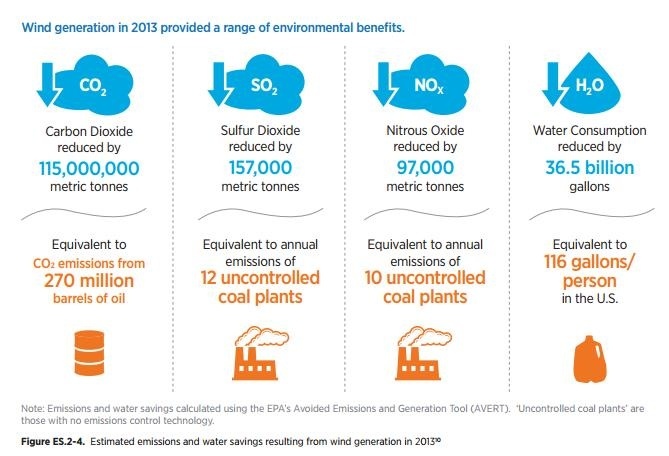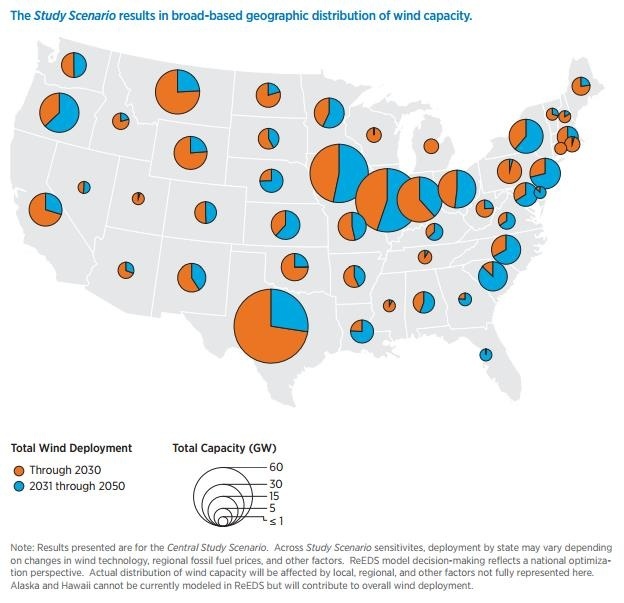News Release from windfair.net
Wind Industry Profile of
Report Excerpt - Wind Vision: A New Era of Wind Power in the United States
Wind Vision: A New Era of Wind Power in the United States was released today by the White House and the U.S. Department of Energy after two years of research and peer review. The definitive new report updates and extends a 2008 Bush Administration report, “20% Wind Energy by 2030,” which galvanized the rapid growth of wind to the point that it now generates 4.5 percent of America’s electricity. Wind Vision describes a new scenario for wind to reach 10 percent by 2020, 20 percent by 2030, and 35 percent by 2050, and provides a road map for government and industry to get there.
“We can do this and save you money by doing it,” responded Tom Kiernan, CEO of the American Wind Energy Association (AWEA). “This definitive report provides the wind industry with aggressive targets for the growth of wind energy in America, and we stand ready to meet them. It starts with getting common-sense policies in place, so we can double U.S. wind energy in the next five years."
“This report documents how wind energy already provides major economic and environmental benefits to America, including protecting consumers against energy price spikes, and making deep cuts in pollution and water use,” commented John Kostyack, Executive Director of the Wind Energy Foundation. “As wind becomes one of the country’s top sources of electricity, Wind Vision promises even bigger benefits for decades to come.”
Over 50 industry executives and professionals will serve as ambassadors to educate Americans and elected officials about those benefits, under a year-long joint campaign announced today by AWEA and the Wind Energy Foundation to disseminate the findings. In addition, over 400,000 supporters of wind energy have signed up at www.powerofwind.com to ask state and federal lawmakers to support the needed policies.

The Wind Vision scenario describes how consumers will benefit immediately from more stably priced energy. With more wind energy, electricity prices would be 20 percent less sensitive to fluctuations in the price of fossil fuels, the report finds. Consumers would see $280 billion in economy-wide savings from reduced natural gas prices alone.
Investing in more U.S. wind turbines would pay further economic dividends, such as by creating more jobs and causing further reductions in air pollution. The up-front investment to achieve these benefits will cost electric consumers only pennies a month in the early years, the report shows.
Consumers will see direct savings as wind technology continues to improve and fossil fuel energy sources become more expensive, with annual consumer savings reaching $14 billion a year by 2050, and cumulative savings on U.S. electric bills amounting to $149 billion by then. If fossil fuel prices increase more than expected, electric consumers would start to see direct savings even sooner.

Wind Vision anticipates that the cost of land-based wind energy can still be further reduced 33 percent by 2030. The report finds the industry has already exceeded the cost reductions and growth trajectory outlined in the 2008 report, because of technological improvements and smart, performance-based policies. Through 2013, the U.S. wind industry exceeded that report’s aggressive cost reduction projections by 32 percent and its wind deployment projections by 27 percent.
“The wind industry has a track record of success,” said Kiernan. “We are now a proven technology ready to scale up even further.”
Like land-based wind, as offshore wind technology is adopted in the U.S., its costs will also come down. Wind Vision assumes 3 gigawatts (GW) of new capacity will be built offshore by 2020, 22 GW by 2030, and 86 GW by 2050.

Other findings of the Wind Vision report include:
Current benefits
- As the cost of wind energy has fallen dramatically, wind development has attracted over $100 billion in private investment since 2008.
- The wind industry currently employs more than 50,000 people in the U.S., with a manufacturing supply chain of more than 500 factories across 43 states.
- In 2013, U.S. wind plants reduced carbon pollution by 115 million metric tons, equivalent to 24 million cars’ worth of carbon emissions.
Future benefits
- By providing 20 percent of the nation’s electricity by 2030, wind energy would create an additional 230,000 well-paying jobs, $650 million in annual lease payments to landowners, and nearly $1.8 billion a year in tax payments to communities. By 2050, wind energy would create additional 600,000 well-paying jobs, $1 billion in annual lease payments to landowners, and nearly $3.2 billion a year in tax payments to communities.
- Wind energy has already cut electric sector carbon emissions by over 5 percent; those emissions will fall by an additional 16 percent by 2030 as wind increases from 4.5 percent of our electricity mix to 20 percent.
- Cumulatively through 2050, wind’s pollution reductions would avoid $400 billion in climate change damages. Wind would save an additional $108 billion in public health costs by cutting other air pollutants, including preventing 22,000 premature deaths.
- Wind would conserve 260 billion gallons of water a year by 2050, displacing 23 percent of total U.S. power plant water consumption.
Elements of the road map for achieving the Wind Vision include:
- Improved weather forecasting, and optimized layout of turbines at wind farms for maximum power
- Next-generation technology, and advanced standards and testing
- A robust U.S. manufacturing base and expanded domestic supply chain for advanced materials
- Best practices for performance, reliability, and safety adopted across the industry
- Sufficient transmission lines to deliver low-cost wind energy to population centers.
- Mitigation of public use concerns, clear regulations, and better public understanding
- Workforce development, with technical training from primary schools to universities
- Consistent policies, which unleash the necessary private investment
“Although the report does not analyze the impacts of policies or make policy recommendations, two key measures needed to achieve these results are a stable federal Production Tax Credit and states’ greater use of wind to comply with the Clean Power Plan,” said Kiernan.
“The U.S. can stay on track to a cleaner, more diverse energy portfolio if Congress provides wind energy with the long-term, stable policy it provides to other energy sources.”

To receive more information on this article, our Newsletter or find out more about what w3.windfair.net has to offer, please, do not hesitate to contact Trevor Sievert at ts@windfair.net.
Please don't forget to follow us on Twitter: w3.windfair.net on Twitter
w3.windfair.net is the largest international B2B internet platform in wind energy – ultimately designed for connecting wind energy enthusiasts and companies across the globe.
- Source:
- American Wind Energy Association
- Author:
- Trevor Sievert, Online Editorial Journalist / By AWEA Staff
- Email:
- windmail@awea.org
- Link:
- www.awea.org/...
